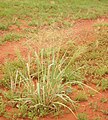The Agriculture Portal

Agriculture encompasses crop and livestock production, aquaculture, and forestry for food and non-food products. Agriculture was a key factor in the rise of sedentary human civilization, whereby farming of domesticated species created food surpluses that enabled people to live in the cities. While humans started gathering grains at least 105,000 years ago, nascent farmers only began planting them around 11,500 years ago. Sheep, goats, pigs, and cattle were domesticated around 10,000 years ago. Plants were independently cultivated in at least 11 regions of the world. In the 20th century, industrial agriculture based on large-scale monocultures came to dominate agricultural output.
As of 2021[update], small farms produce about one-third of the world's food, but large farms are prevalent. The largest 1% of farms in the world are greater than 50 hectares (120 acres) and operate more than 70% of the world's farmland. Nearly 40% of agricultural land is found on farms larger than 1,000 hectares (2,500 acres). However, five of every six farms in the world consist of fewer than 2 hectares (4.9 acres), and take up only around 12% of all agricultural land. Farms and farming greatly influence rural economics and greatly shape rural society, affecting both the direct agricultural workforce and broader businesses that support the farms and farming populations.
The major agricultural products can be broadly grouped into foods, fibers, fuels, and raw materials (such as rubber). Food classes include cereals (grains), vegetables, fruits, cooking oils, meat, milk, eggs, and fungi. Global agricultural production amounts to approximately 11 billion tonnes of food, 32 million tonnes of natural fibers and 4 billion m3 of wood. However, around 14% of the world's food is lost from production before reaching the retail level.
Modern agronomy, plant breeding, agrochemicals such as pesticides and fertilizers, and technological developments have sharply increased crop yields, but also contributed to ecological and environmental damage. Selective breeding and modern practices in animal husbandry have similarly increased the output of meat, but have raised concerns about animal welfare and environmental damage. Environmental issues include contributions to climate change, depletion of aquifers, deforestation, antibiotic resistance, and other agricultural pollution. Agriculture is both a cause of and sensitive to environmental degradation, such as biodiversity loss, desertification, soil degradation, and climate change, all of which can cause decreases in crop yield. Genetically modified organisms are widely used, although some countries ban them. (Full article...)
Selected article
A wide range of agriculture is practiced in Canada, from sprawling wheat fields of the prairies to summer produce of the Okanagan valley. In the federal government, overview of Canadian agriculture is the responsibility of the department of Agriculture and Agri-Food.
Agriculture in Canada comprises five main agricultural production sectors of commodity production resulting in farm cash receipts from both domestic and foreign markets.
Horticulture which includes garden crops, and fruits became easier to grow with the development of plant hardiness zones.
Apples, pears, plums and prunes, peaches, apricots, cherries, strawberries, raspberries, loganberries and fruit orchards are numerous and reach commercial size in the Annapolis Valley of Nova Scotia, New Brunswick, Quebec, Niagara Peninsula and Norfolk County of Ontario and Okanagan Valley of British Columbia.
Hazelnuts are harvested in Eastern Canada and British Columbia. Maple syrup and maple sugar, maple butter, and maple taffy are products of Quebec along the St. Lawrence River. The main market for Canadian maple syrup and sugar is the United States. Potatoes are an abundant harvest of the Maritime provinces. Sugar beets and beet root sugar are harvested in Quebec, Ontario, Manitoba, and Alberta.
115,000 cattle roamed the southern prairies by 1900. Livestock can include the raising of cows, also commonly called cattle. Recently domestication of the buffalo and elk has initiated a new food industry. Sheep have been raised for both wool and meat. Bovine or pig barns have been a part of livestock culture. Scientists have been making forward steps in swine research giving rise to intensive pig farming. The domestication of various farm animals meant that corresponding industries such as feedlots, animal husbandry and meat processing have also been studied, and developed. (Full article...)
Selected image
Did you know...
General images
Related portals
Topics
Categories
Things you can do
- – When a task is completed, please remove it from the list.
WikiProjects
Associated Wikimedia
The following Wikimedia Foundation sister projects provide more on this subject:
-
Commons
Free media repository -
Wikibooks
Free textbooks and manuals -
Wikidata
Free knowledge base -
Wikinews
Free-content news -
Wikiquote
Collection of quotations -
Wikisource
Free-content library -
Wikiversity
Free learning tools -
Wiktionary
Dictionary and thesaurus
Agriculture journals

- Agronomy Journal - the American Society of Agronomy
- Agronomy for Sustainable Development Journal
- European Journal of Agronomy
- Journal of Agronomy and Crop Science
- Journal of Organic Systems
- Agriculture, Ecosystems & Environment
- Agriculture and Human Values
- Computers and Electronics in Agriculture
- Precision Agriculture
- Experimental Agriculture
- Journal of Integrative Agriculture
- Journal of the Science of Food and Agriculture
- Renewable Agriculture and Food Systems
- Biological Agriculture & Horticulture
See also:




































































